The information provided below is just a very brief overview of the Regiments represented by the names carried on the Class 45's. Any historical references are purely highlights, in most cases the Battalions within the Regiments might be dispersed to different parts of the world at the same time - some might be involved in well known battles and conflicts whilst others might serve their deployment with the minimum of fuss.
If interested there is a vast wealth of information on the internet, simply type the regiment name into a search engine, and then step back into history!
![]()
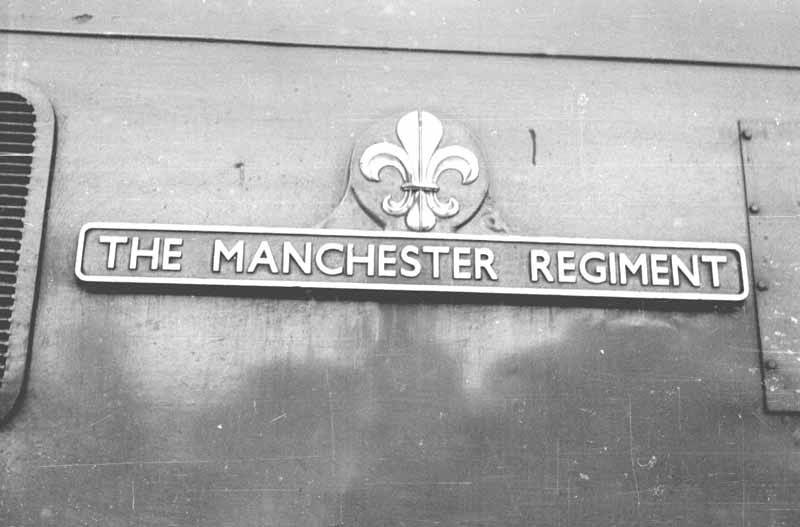
The Manchester Regiment can trace its roots back to 1756, serving in the American War of Independence & the Crimea. It was not until 1881 that it became known as 'The Manchester Regiment', then seeing service in the Second Boer War & The Great War - on the first day of the Battle of the Somme, July 1st 1916, over 660 members of the Regiment were lost. World War Two brought action in Burma, Malta, Italy and other parts of Europe. Action was also seen in the Malayan Emergency of 1951/54. Army changes in 1958 found The Manchester Regiment merged with the King's Regiment (Liverpool), to become The King's Regiment (Manchester & Liverpool).
49 / 45039 was in service for just over nineteen years from October 1961 to November 1980, starting its career at Cricklewood and ending its days allocated to Holbeck. It was taken out of service at Tinsley, quickly moved to Swindon but lingered there until April 1983. This was the only Derby built Class 45 to carry a name, all the others were Crewe built.
![]()
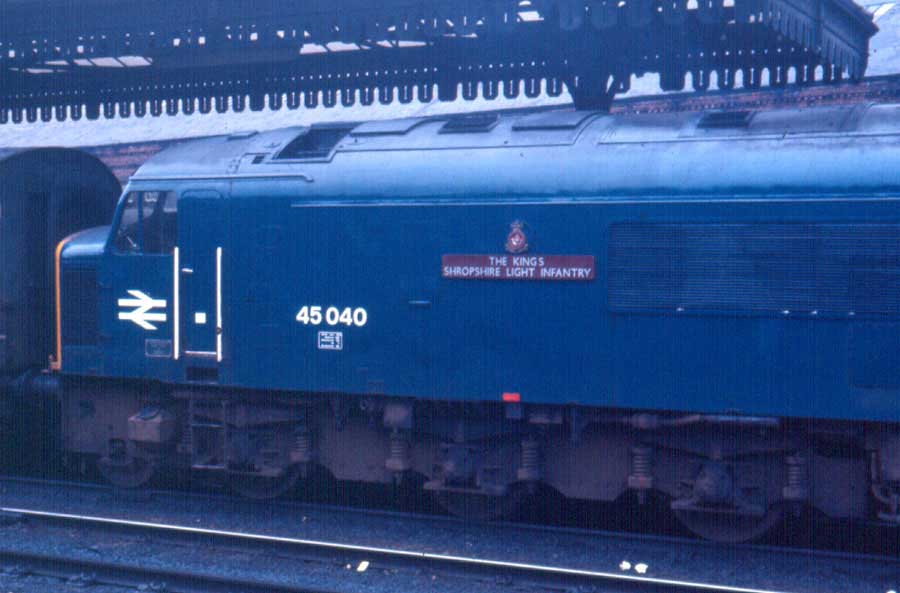
The King's Shropshire Light Infantry can be traced back to two Regiments, the 53rd (Foot) & the 85th (Light Infantry). The 53rd was raised in Bridgnorth in 1755, its first overseas posting was to Quebec in 1776, remaining until 1777 on the North American continent. After arrival back in England they were renamed the 53rd of Shropshire Regiment.
During the 19th century they were well travelled, to India, Nepal, St Helena. After a break they returned to India, remaining here between 1823 & 1860. Further tours included Ireland & Canada. In 1881 they were renamed the 1st Battalion King's Light Infantry (Shropshire) Regiment.
The 85th Light Infantry were raised in 1759 in Shrewsbury, visiting Spain in 1762, but were disbanded/reformed in 1763 & 1783, the latter perhaps due to the major loss of life suffered by the sailing vessel Ville De Paris in a hurricane off Newfoundland. During the 19th century they were active in Madeira, Jamaica, Spain - in 1813 making visits to Washington & New Orleans. Further tours took them to Malta, West Indies, Ireland, Mauritius, South Africa, India & Afghanistan. In 1881 they were renamed the 2nd Battalion King's Shropshire Light Infantry.
From 1881 the two original parts were combined, seeing more service in Egypt, Cyprus, Mauritius and China before closing out the century with action in the Boer War. The Great War found the KSLI in France, India, South Russia and Hong Kong. World War Two saw them with the BEF in France, then North Africa, Syria, Palestine and Europe, taking part in the landings at Anzio and Normandy (Sword Beach)
Later conflicts included Korea (1951), Kenya (Mau Mau), Bahrain (1958), Singapore, Malaysia & Mauritius. A major realignment in July 1968 found the new Light Infantry formed out of four existing groups, including the KSLI. (Photograph above is at York on April 17th 1976).
50 / 45040 was originally to have been constructed at Derby, but the order for 50 - 67 was transferred to Crewe. 50 was delivered during June 1960 to Cricklewood, it would survive for twenty five years being withdrawn in July 1987 from Tinsley. It would been reinstated two months later at Thornaby and renumbered 97412 for use on wiring trains between Newcastle & Berwick.
The locomotive was named during July 1965. It was the last locomotive to haul a freight over the Nottingham - Ruddingston line on April 7th 1974 prior to the opening of the Loughborough chord. It received a light repair at Derby in May 1984. When withdrawn in July 1987 it was in full working order, simply surplus to stock.
![]()

Sir Robert Peyton raised up the 20th Foot in the Exeter area during 1688. They fought in the Battle of the Boyne in 1690, whilst their first battle honours were at Namur in 1695. The War of Spanish Succession followed in 1702. During 1745 the 20th were sent to Scotland to put down the rebellion, a decade later it was off to France to deal with the Seven Years War. During the American War of Independence all four of the Fusilier groups visited the Colonies, before heading off to the West Indies. More time was served in Portugal trying to evict the French, culminating at the Battle of Corunna.
It was back to Spain in 1812 for the second invasion again dealing with the French and involving the battle of Vittoria. The 20th served in Crimea. In 1881 the 20th Foot became the Lancashire Fusiliers, after one hundred years association with the region. As the century closed it was off to South Africa for the Boer War conflict.
The Great War found the 20th at Gallipoli in the thick of it. During World War Two action occurred in north west Europe, Tunisia & Italy. In April 1958 the six Fusilier associations combined to become the Fusilier Brigade, in 1968 they became the Royal Regiment of Fusiliers.
52 / 45123 was new to Derby in June 1962 living out most of its life allocated to LMR depots. Within a month of being introduced 52 was at Inverness on July 14th 1962 working the 11.10am to Glasgow. It was named at Manchester Piccadilly on Halloween 1963. It would become one of the fifty Peaks selected to receive ETH equipment to operate the newer airconditioned coaching stock on the St Pancras - Sheffield services. During April 1983 45123 received a General/Refurbishment repair at Crewe, although it had spent almost a year languishing at the Works. Twenty four years of service came to an end in July 1986 when the locomotive sustained collision damage. Initially stored at Toton it was eventually moved to Vic Berry's, Leicester and broken up in the summer of 1988.
![]()
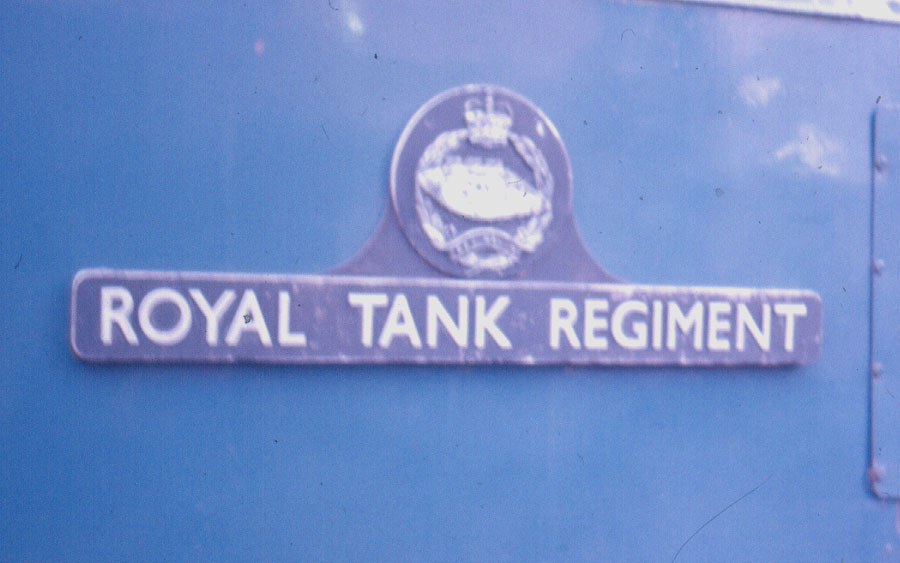
The Royal Tank Regiment finds its beginnings in the original armoured car pioneers of The Great War. The first tanks, introduced in 1916 were manned by members of the Machine Gun Corps. In 1917 the battalions were renamed the Tank Corps. Perhaps the most formidable array of the early tank forces occurred at Cambrai in November 1917.
After the War's end detachments were sent to Russia in an attempt to defeat the Bolsheviks. In 1923 'Royal' was added to the Corps name, now using the motto 'Fear Naught'. In the inter-war years the Tank Corp saw service in Iraq, Persia, Palestine, India & Egypt.
In 1939 the name changed to Royal Tank Regiment. They were in France as part of the BEF, initial successes could not be sustained, ending their action at Dunkirk. In North Africa a big part was played in the defeat of the Italians & Germans. D-Day was the first part in a series of actions for the Tank Corps, culminating in the crossing of the Rhine towards the end of the war in Europe. Support was also provided in Austria, Greece, Algeria, Abyssinia, Iraq, India & Burma amongst other locations.
Post-war activity saw the Tank Regiment stationed in many placed throughout the world, as recently as 1999 serving in Kosovo.
53 / 45041 was delivered to Derby during July 1962 and would spend the next twenty six years allocated to LMR & ER depots. It was named at Derby Works on September 24th 1964. It received a light repair at Derby during August 1985 and would be the last Class 45/0 to receive any type of repair at Derby, during July 1986 to its main generator. Whilst working a Tees - Scunthorpe freight on December 11th 1986 it was involved in a fatal collision at Rillington level crossing.
The end came on June 8th 1988 at Thornaby, finally stopped with traction motor defects. After five years in store the Peak was moved to The Railway Age, Crewe for preservation.
![]()
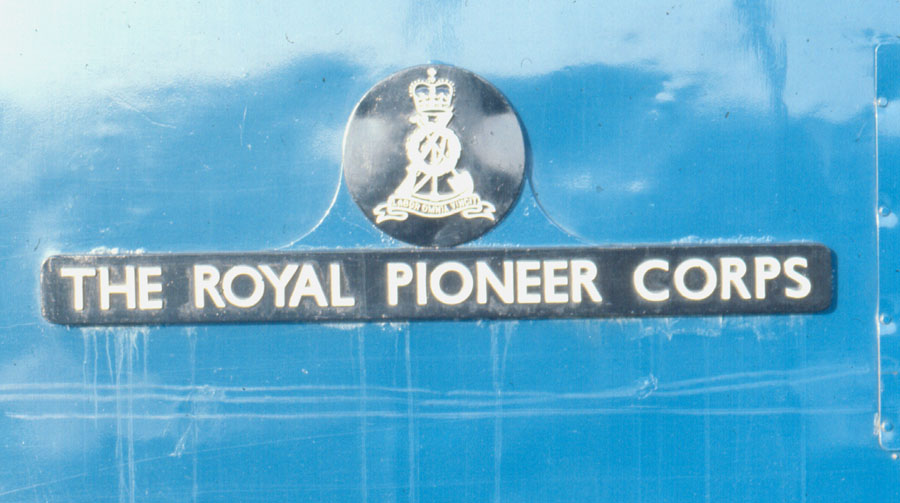
The nameplate for 54 / 45023 is seen here on October 20th 1979. The latin inscription reads 'Labor Omnia Vincit' - Work Conquers Everything.
The Royal Pioneer Corps can trace their roots back to the mid 18th Century, though until World War One the group was disbanded and re-established several times. They served in Crimea in the 1850's and during the 1914 - 1918 'Great War' served in multiple roles including the laying of light rail lines to the front. The Pioneer Corp badge, featuring the wreath, shovel, pick & gun was unveiled.
During World War Two the Pioneer Corps were found in all theatres of the War, featuring heavily in the North Africa landings, acquitting themselves very well in several battles. They were also in the front line at D-Day, clearing mines on the beaches and creating roads for vehicles arriving at the beach head. Late in 1946 'Royal' was added to the name and in 1950 the Corps became regular army.
The history of the Corps is marred by the events that overtook the 16,000 ton Cunard liner 'Lancastria' in use to evacuate persons from France during 1940. Whilst heavily overloaded the ship was bombed and sunk off the coast of St Nazaire with tremendous loss of life. Approximately 2,500 souls were saved, it is believed when sunk the ship was carrying 6,000 - 9,000 passengers. A 'D' notice delayed the immediate release of the loss to the British public and the official reports remain sealed until 2040. Amongst the evacuees on the ship were a great many members of the Pioneer Corp.
During 1993 the Royal Pioneer Corps was combined with a number of other units to form the Royal Logistics Corp.
54 / 45023 was delivered to Derby during September 1962 and would spend most of its time allocated to LMR depots. It was named at St Pancras on November 14th 1963. It was loaned to the CEGB at Willington Power Station during October 1968 to substitute for an exciter under repair, running for 340 hours non-stop. Its only time away from LMR depots was when on allocation to Tinsley from February 1979 to January 1982.
In June 1980 it survived a visit to Swindon Works for electrical repairs, but succumbed at Derby Works in September 1984 with worn tyres, twenty two years in service. It languished at Derby Works for twenty months before being dragged to Vic Berry's Leicester for breaking up during December 1986.
A crest carried by this locomotive sold for GBP1,500 at auction in January 2002.
![]()
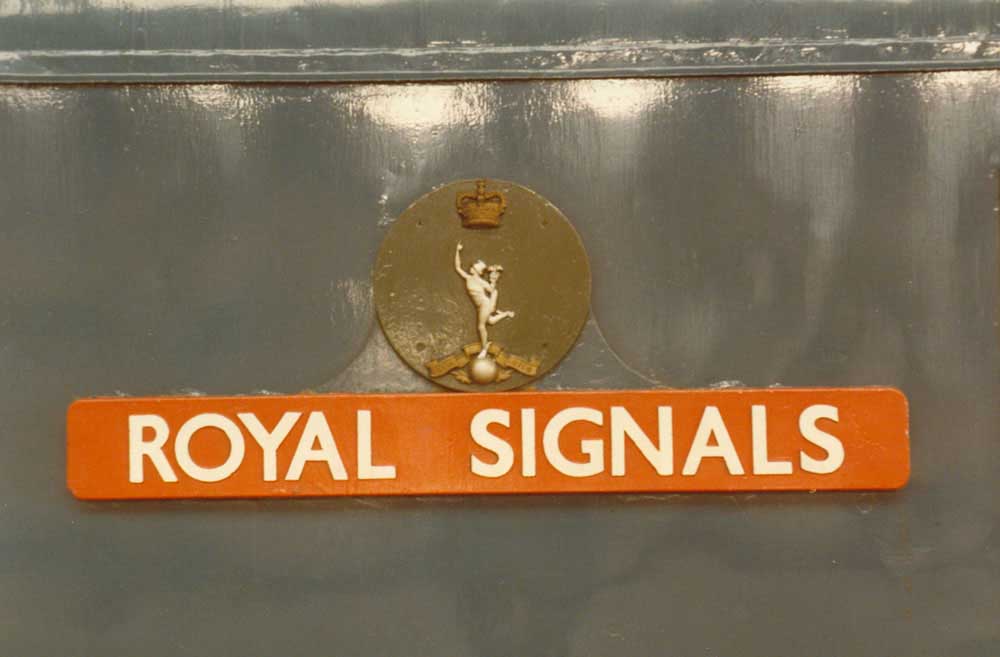
The Telegraph Battalion Royal Engineers was founded in 1884, first taking part in the Nile Campaign, then the Ashanti Campaign of 1895 - 1896 and shortly thereafter the Boer War. In 1908 the Royal Engineer Signals Service was formed and became responsible for communications during The Great War. Wireless communications were provide in France, Salonika, Palestine & Mesopotamia. In August 1920 the title Royal Corps of Signals was created.
Prior to World War Two the Corps were serving at many points of the Empire, the largest concentration being in India - by War's end the Corps had just over 150,000 officers and men scattered across the globe. After 1945 the Corps continued a strong presence overseas, in Palestine, Malaya, Korea, Suez and other well known British outposts. Because of the Cold War the largest concentration of Signal Corp remained with the Army of the Rhine facing Russia and the Communist Bloc countries.
Peacekeeping roles have prevailed mostly since the end of the Cold War, from East Timor to Cambodia to Sierra Leone, under the motto 'Certa Cito' - Swift & Sure.
55 / 45144 - another Peak to prinicipally be allocated to LMR depots, 55 was new to Derby in October 1962. 55 was named on June 30th 1965. One of the fifty selected to carry ETH equipment 45144 received its General/Refurbishment at Crewe during March 1984, the last of the Class to be so treated here. It would leave the LMR in November 1986 when all the remaining Class 45/1's were allocated to Tinsley.
Its twenty five years of service appears to have ended on the WR, on December 16th 1987 it was noted working the 19.00 Taunton - Bristol, five days later it was withdrawn at Bristol after derailing at Malago Vale Carriage Sidings. It was eventually dispatched direct to Vic Berry's Leicester, ending its days their in July 1988.
![]()

Archibald Douglas's Regiment of Foot was raised in the Reading area during 1688, and known by its leaders names until 1751 when it became the 16th Regiment of Foot. In 1782 'Buckinghamshire' was added to the title which in 1809 was changed to 'Bedfordshire', titles having been swapped with 14th Foot.
(Nameplate view from June 12th 1979.)
In the 1881 reorganisation the Regiment now included Hertfordshire in its geographic catchment area. It would not be until 1919 that 'Hertfordshire' would be included in the Regimental title.
In 1958 the Essex Regiment was amalgamated with the Bedfordshire & Hertfordshire Regiment to become the 3rd East Anglian Regiment.
56 / 45137 was new to Cricklewood early in December 1962, it was not long in service before it was named on December 8th 1962. Mostly an LMR allocated locomotive it would be ETH equipped in the early 1970's. It would receive a General/Refurbish at Derby Works during December 1981. 45137 would move from the LMR for the first time when it was allocated to Tinsley in November 1986. It would haul the last official Class 45 hauled train out of St Pancras, the headboard fitted 16.20 to Nottingham on May 10th 1987.
A month later and just short of twenty five years service 45137 was retired on June 15th 1987. However it would linger for almost another seven years before being dispatched to Glasgow for breaking up, ending its days there in March 1994.
![]()
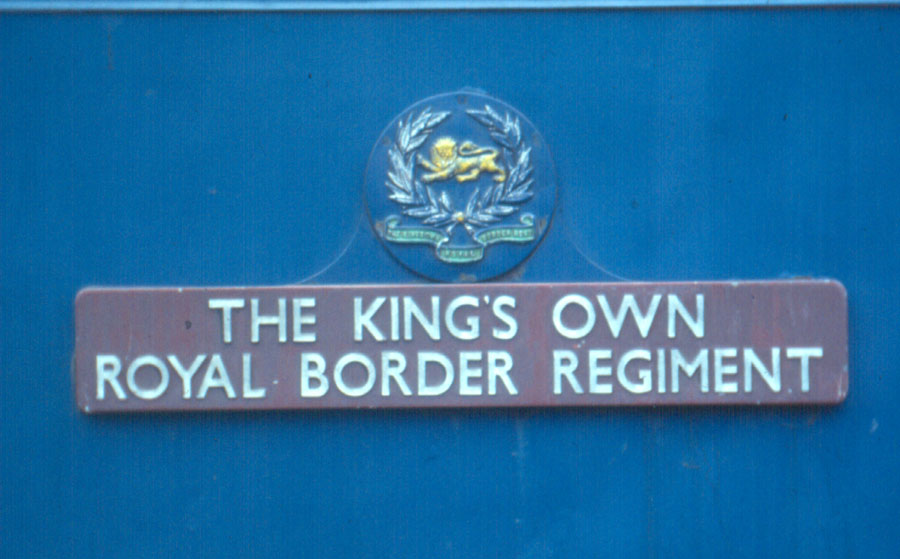
The King's Own Royal Border Regiment can trace its roots back through three lines; the 4th King's Own Royal Border Regiment (Lancaster), dating back to 1680; the 34th Cumberland Regiment from 1702 and the 55th Westmorland Regiment from 1755. In the reorganisation of 1881 the latter two became the Border Regiment. In October 1959 the Border Regiment combined with The King's Own Royal Regiment to become the King's Own Royal Border Regiment.
The 4th of Foot was the first to support William of Orange in 1688, being so honoured by the right to wear the lion of England as its badge. Its first battle honours were won at Namur in 1695. The 34th of Foot fought a famous rearguard action at Fontenoy in April 1745 allowing it to wear a laurel wreath on its colours. Other famous locations featuring the regiments include Arroyos Dos Molinos (1811), Waterloo, Nanking (1841), as the century closed out the reformed regiments were active in South Africa.
In the Great War the regiments fought in France, Italy, Gallipoli and Macedonia. In World War Two their actions were well scattered, from India to Iraq, Sicily, Arnhem and the Far East. After the end of the war the Regiments saw service in some familiar locations: Southern Cameroons, Germany, British Guiana & Bahrein to name but a few.
58 / 45043 was new to Derby in February 1962 (58 to 67 were delivered ahead of 50 to 57), and was soon named at Carlisle on May 1st 1963. Mostly an LMR locomotive with some time spent at Holbeck & Tinsley it would soldier on for twenty two years until retired in September 1984. It would quickly be sent to Derby Works, remaining here until May 1986, making the short trek to Vic Berry's Leicester, being broken up there in January 1987.
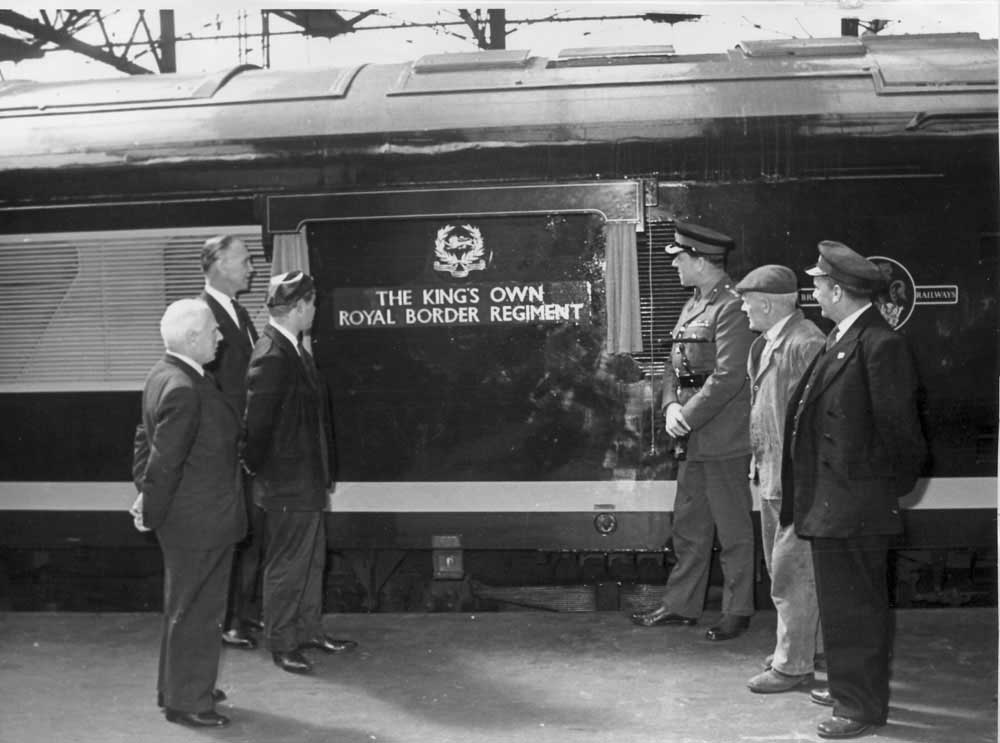
Photographer unknown.
The above view was acquired through ebay, the seller having acquired it in a clearance lot - the photograph was pasted onto a sheet with a typed caption which identifies fireman A Gray as 'myself', presumably this photograph came from a collection maintained by Mr Gray.
![]()
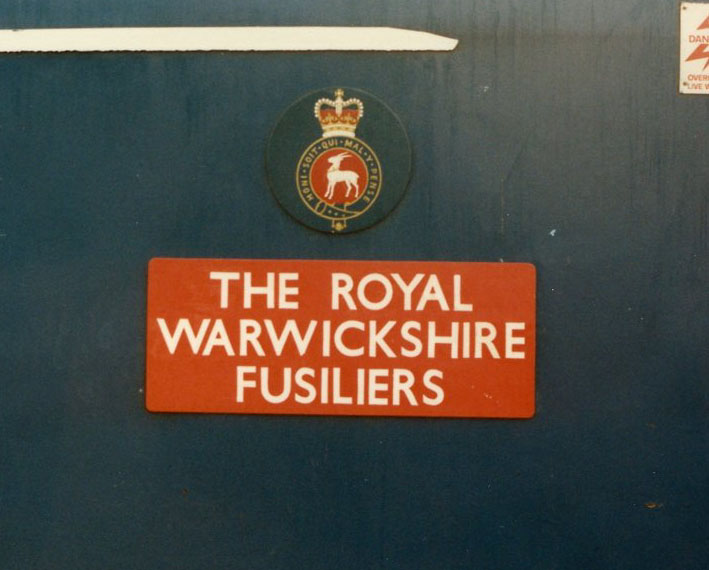
The Lillingstone Regiment, used by the Dutch in 1674 to fight the French was the forerunner of the Royal Warwickshire Fusiliers. In 1743 they were renamed the 6th Regiment of Foot, during 1778 they spent time recruiting in the West Midlands. Training barracks were established outside of Warwick, the 6th Foot now being recognised as the First Warwickshire Regiment of Foot.
In 1832 'Royal' was added to the name, and the reorganisation of 1881 saw the regiment name shortened to The Royal Warwickshire Regiment.
The Royal Warwickshire Regiment became Fusiliers in May 1963, consolidated with three other Fusilier regiments. A further consolidation took place in 1968 with the four English Fusilier regiments combined to form the Royal Regiment of Fusiliers.
59 / 45104 - another of the Class 45s that would become ETH equipped, it began its career allocated to Derby in February 1962 and would spend most of its twenty six years allocated to LMR depots. It was named at Platform 7, Snow Hill station, Birmingham by the Mayor of Birmingham & Major General R C McDonald.
It received a light repair at Derby in June 1985, was transferred to Tinsley in November 1986, during 1987 was a celebrity at Bounds Green Open Day on May 4th and Norwich Open Day on May 30th. Its working days ended on April 13th 1988, condemned with collision damage. It would linger for four more years until broken up at MC Metals, Glasgow in February 1992.
![]()
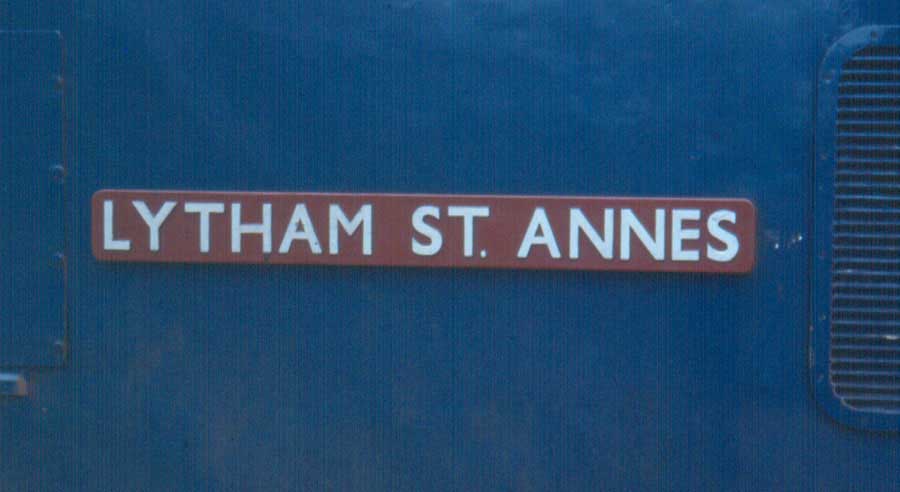
Patriot 4-6-0 No. 45548 had carried the 'Lytham St. Annes' name from 1937 to its withdrawal in 1962. It had been one of thirteen LMS locomotives named after holiday resorts.
60 / 45022 The oddly name Lytham St Annes was new to Derby in February 1962 and like many other Peaks would spend its time mostly allocated to LMR & ER depots. Its time at Holbeck saw it as a regular vistor to the Waverley route, on January 5th 1969 it was in charge of the last scheduled passenger train over this route, the Up 21.55 Edinburgh - St Pancras 'Waverley'.
It received a light repair at Derby in November 1980 and an intermediate repair, also at Derby in February 1985. After just over twenty five years of service the locomotive was retired on July 26th 1987, in full working order, but surplus to requirements. In September 1987 it was reinstated and renumbered 97409 for use on the ECML electrification. It was finally retired due to a battery fault, but worked under its own power to March for storage. It ended its days at MC Metals Glasgow during October 1991.
![]()
This Corps can trace its heritage back to the Office of Ordinance in 1414. However it was not until 1922 that it gained the title Royal Army Ordnance Corps. In 1993 it amalgamed with four other sections to become the Royal Logistic Corps.
61 / 45112 was delivered to Derby in March 1962 spending most of its working life attached to LMR depots. It was named at Derby Works on September 14th 1965. It received a general/refurbish at Derby Works during May 1980, transfer to Tinsley came in November 1986 and it would remain in service until May 7th 1987. It would be one of the fortunate Peaks to survive into preservation.
![]()
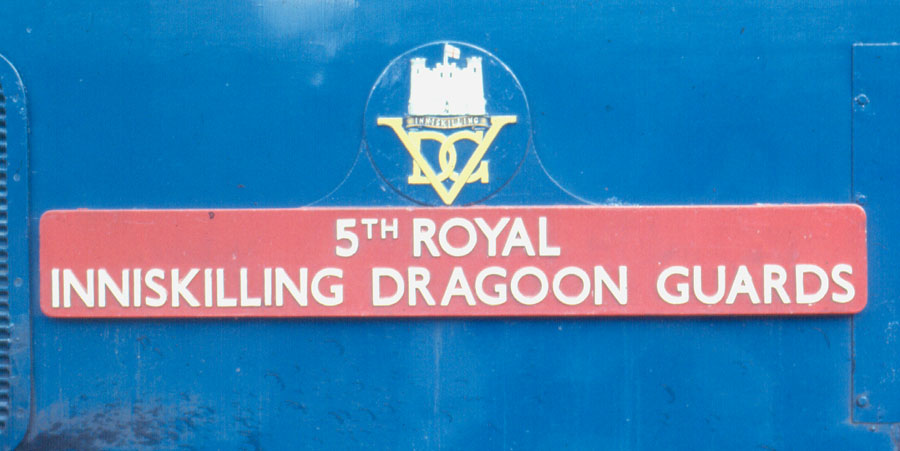
The formation of the 7th Horse, formed from the regimentation of troops raised since 1685 from various parts of England is one of the two sources of the '5th Royal Inniskilling Dragoon Guards'. In 1751 the 2nd Horse (formerly the 6th Horse and 7th Horse) became the 5th Regiment of Dragoon Guards, later circa 1823 the 5th (Princess Charlotte of Wales's) Dragoon Guards. The other source dates from 1689 with Sir Albert Cunningham's Regiment of Dragoons amalgamated from several Irish sources at Enniskillin. These later became the 7th Dragoons, the 6th Dragoons & the Black Dragoons. In 1751 they became known as the 6th (Inniskilling) Regiment of Dragoons. By 1921 they were known as The Inniskillings (6th Dragoons).
In 1922 the two Regiments were consolidated into the 5th/6th Dragoons, and in 1935 the familiar 5th Royal Inniskilling Dragoon Guards title was established. As the cavalry regiments mechanised as World War Two approached the 5th Royal Inniskilling Dragoon Guards became part of the Royal Armoured Corps in 1939.
In 1992 the Regiment amalgamated with 4th/7th Royal Dragoon Guards to form The Royal Dragoon Guards.
62 / 45143 This locomotive was new to Derby in March 1962, again being principally allocated to LMR depots. During the early 1970's it would become one of fifty Peaks equipped with ETH capability.
It was used in celebration of the 300th anniversary of 5th Royal Inniskilling Dragoon Guards at Waterloo on June 11th 1985. 45143 had been specially prepared by Toton, arriving at Waterloo on the 05.48 ex-Exeter, the regimental band entertained crowds prior to the Duchess of Westminster renaming the locomotive with '1685-1985' added to the nameplate. After the ceremony it worked the 13.10 Waterloo - Exeter.

Nameplate and crest after the addition of the 1685 - 1985 wording, seen here at Reading on December 28th 1985. 45143 was noted at Derby Works in July 1986 receiving repairs to bogie fractures, shortly afterwards in November it was transferred to Tinsley. Its twenty five years of service ended on May 7th, 1987 although it would not be broken up at MC Metals, Glasgow until March 1994.
A nameplate from this locomotive with crest sold at auction for GBP10,800 in March 2004.
![]()
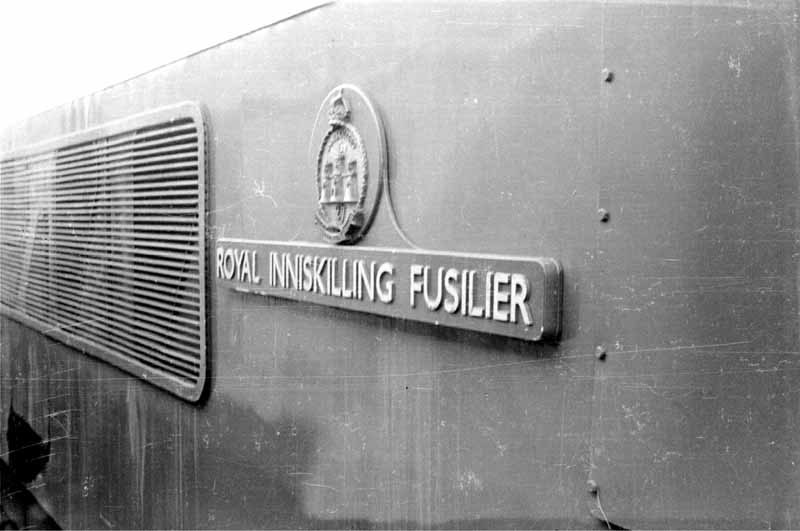
Created as Z. Tiffin's Regiment of Foot at Enniskillen in 1690, this militia would be known by its colonels names until 1747 when it became the 27th Regiment of Foot, Inniskilling was added in 1751. In the 1881 reorganisation it amalgamated with the 108th Regiment of Foot to become the Royal Inniskilling Fusiliers. This was recognised as the county regiment of Fermanagh, Londonderry, Tyrone & Donegal.
In 1968 The Royal Inniskilling Fusiliers combined with the Royal Ulster Rifles & the Royal Irish Fusiliers to become the Royal Irish Rangers.
63 / 45044 was new to Derby in April 1962, and would be yet another Peak with lengthy spells allocated to LMR depots. It would receive an intermediate repair at Derby Works in October 1983. After twenty five years service it was withdrawn on June 15th 1987, ending its days at MC Metals, Glasgow in February 1989.
![]()
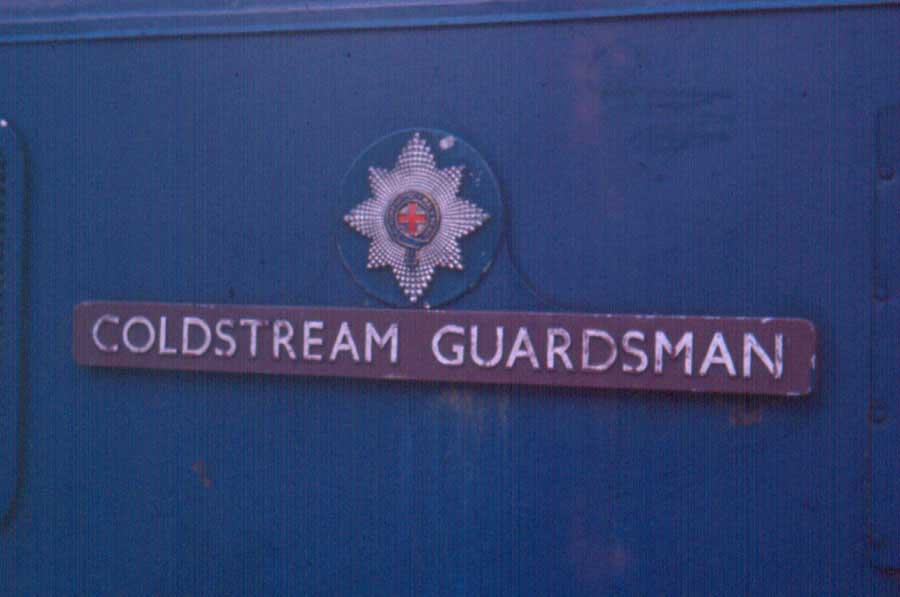
The earliest beginings of the men represented by the 'Coldstream Guardsman' nameplate occur when Cromwell created the New Model Army in 1645. One group of soldiers so impressed Cromwell that in 1650 Monck's Regiment of Foot was founded from men principally joining from the Newcastle area. Their first major action was the Battle of Dunbar in September 1650, later followed by their march on Edinburgh.
Other notable battles from the 17th century include Flanders, Sedgemoor & Tangier. The 18th century found them all over Europe and into the American colonies. It was off to Egypt, Portugal, Canada, the Crimea, more Egypt and then involvement in the Boer War. Perhaps their most notable action during the 19th century was at Waterloo in the action at Chateau Hougoumont where a small British force seriously delayed a much larger force of French troops from reaching the main battle.
The Great War saw much action, in the first battle of Gheluvett one of the battalion's twice lost all its officers and many of its men. World War Two found the Guardmen assisting the British Expeditionary Force in France and later action in North Africa and across Europe.
Lesser action after World War Two took them to North Malaysia, Palestine, Kenya, Aden, Mauritius and Cyprus. Battle Honours in total ran to 117. 'Nulli Secundus' - Second to None.
64 / 45045 This locomotive was delivered new to Derby in April 1962 and would spend its twenty one years of service attached to LMR depots. It was named during July 1965. Derby Works gave it a light repair at during July 1980, unfortunately its service career ended prematurely on February 10th 1983 when it collided with a substantial structure at Saltley, after evaluation at Derby Works it was retired on May 9th 1983. It lingered for three more years, mostly at Derby Works, until hauled away to Vic Berry's, Leicester for final breaking up during October 1986.
![]()
The origins of 'The First or Grenadier Regiment of Foot Guards' can trace its roots back to the exiled King Charles II in Bruge in 1656. From this point the Regiment has fought in almost every major campaign involving the British Army, including such famous names as Schellenberg, Fontenay, Corunna & Waterloo, where they received their present day title.
At Inkerman (Crimea) half the officers & men were lost, but the ground was held. Other famous locations include Tel-el-Kebir and the Boer War battles. During The Great War the regiment fought in all the major battles, suffering in excess of 12,000 casualties. During World War Two it was with the British Expeditionary Force, later defending the perimeter of Dunkirk. They took part in the 8th Army advance to Tunisia, in the D-Day landings and the advance across Europe. After 1945 they have taken part in most of the campaigns involving the British Army.
65 /45111 was delivered to Derby during April 1962, the start of a career that would last just over twenty five years. It was named during July 1965. It received a general/refurbish at Derby Works during May 1981 and is believed to have been the last Peak to carry its original nameplates, at least up to January 1987.
45111 was withdrawn on May 7th 1987 and languished another five years before ending its days at MC Metals, Glasgow in July 1992.
![]()
The Battle of Cr cy in 1346 saw the introduction of artillery into the English army, Henry VIII made the army's artillery semi-permanent in the 16th century and made a permanent in 1716.
The Royal Warrant of May 26th 1716 from George I created two regular companies of field artillery, each 100 men strong, were raised at Woolwich.The title Royal Artillery was first used in 1720. By 1862 the regiment comprised 190 batteries (horse/field/heavy). By 1917 there were 548,000 men in 1,769 batteries. During the World War Two there were over 1 million men serving in 960 gunner regiments. The end of National Service and the Cold War saw the reduction in size of the Royal Artillery to 21 regiments.
67 / 45118 was delivered new to Derby during May 1962. It would receive a general/refurbish at Derby Works during October 1980 and would be the last Class 45 to receive a scheduled classified repair at Derby Works during April 1986. Eight months later in January 1987 it was the last Peak to recieve any type of attention at Derby Works, swapping its bogies with those from condemned 45116.
45118 would be withdrawn during May 1987.
![]()
The Regiment of Fusiliers was created following the Monmouth Rebellion of 1685 to equip English forces with resources to combat the French 'Fusil'. Later known as the 7th Foot it was referred to by the King as the Royal Regiment of Fuzileers. The 7th fought at Namur in 1695 followed by the war of Spanish Succession. The 7th also took part in the American War of Independence and then returned to Spain in 1812 for a second invasion, gaining fame at the Battle of Albuhera & Vittoria.
The 7th fought in Crimea, and closed the century out in the Boer War. The Great War found all the Fusiliers active, taking part in many of the battles involving great carnage, the 7th were also in the thick of it at Gallipoli. World War Two of course found the Fusiliers active, particularly in north west Europe, Tunisia, Italy & Burma.
In April 1958 the six Fusilier associations were combined to become the Fusilier Brigade, which later in 1968 became the Royal Regiment of Fusiliers.
68 / 45046 was the first of the Crewe built Peaks, delivered to Crewe in September 1960. Amidst the regular diet of LMR allocations it was loaned to the WR briefly during July 1961. During these early days it also visited Horwich Works for boiler repairs during October 1961.
It would receive a light repair at Derby Works during December 1984 and would have its boiler finally isolated in June 1985. Its service life, almost twenty eight years, ended on August 2nd 1988, the last Class 45/0 in service, and withdrawn in full working order. It would be broken up at MC Metals Glasgow during February 1992.
![]()

45048 The Royal Marines at Llandudno on September 8th 1979, photograph courtesy Larry Goddard.
'Per Mare Per Terram' - By Sea, By Land. The capture & defense of Gibralter in 1704 was considered by George IV to be the most glorious achievement of the Royal Marines and is considered representative of the many honours they would earn.
70 / 45048 was new to Crewe in December 1960, being allocated to a number of LMR & ER depots. It was named during December 1964. It hauled the first service out of Alfreton & Mansfield Parkway on May 7th 1973, on a special to London. Its last overhaul was at Derby Works during June 1979. It was withdrawn at Toton six years later on June 25th 1985 with multiple faults. It would eventually be sent to MC Metals, Glasgow for breaking up during December 1988.
![]()
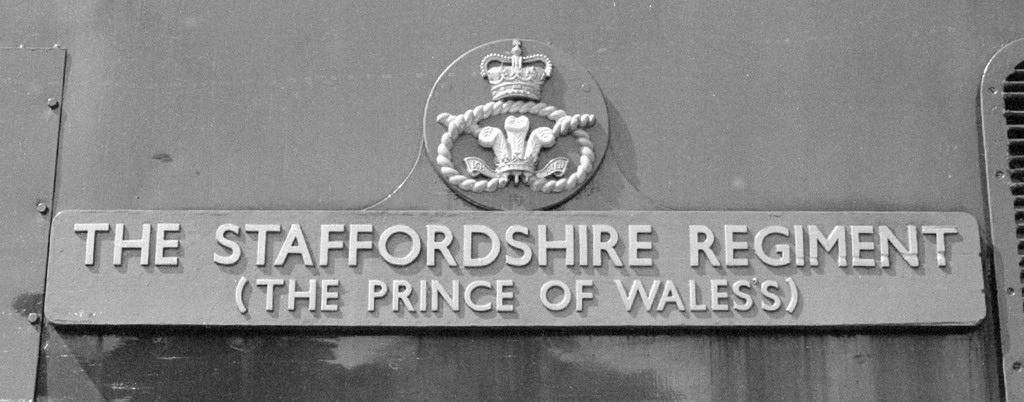
The raising of a force of men at Litchfield in the spring of 1705 was the genesis of the Staffordshire Regiment. Initially fighting in the West Indies against the French & Spanish, the original 38th & 64th Regiments would soon fight in the early part of the American War of Independence at Bunker Hill & in the taking of New York. In 1782 they became the 1st & 2nd Staffordshires, fighting in Flanders, Martinique, Egypt - to kick out Napoleon, St Lucia, Surinam, Cape of Good Hope & Montevideo.
After several decades of relative peace it was off to Burma, then China in 1842 - The Opium War, the Sikh War of 1844, Crimea in 1853 and India in 1856, notably at Cawnpore & Lucknow. In 1876 the future King Edward 7th bestowed 'Prince of Wales' to the regimental name. Familiar names followed with the Zulu War of 1879, and the failed attempt to save Gordon at Khartoum in 1884. Then came the Boer War at the close of the century.
In The Great War the troops were heavily involved in the battles at Mons & Ypres, later they would be off to India. World War Two found them with the BEF in France, then in North Africa, to the landings at Sicily, Anzio & Normandy. At Arnhem the 2nd South Staffordshires, operating as an airborne unit earned the unique honour of one battalion gaining two Victoria Crosses in one battle during the course of the war.
After World War Two came service in Hong Kong, Germany, Palestine, Egypt, Kenya (1959), Uganda and Belize (1977).
71 / 45049 started its twenty seven year career during December 1960 at Crewe, it would be named on May 20th 1966. A general repair was received at Derby Works during February 1983. Retirement would come on October 27th 1987, the result of damage sustained after catching fire on the 11.03 Liverpool - Newcastle on September 5th. MC Metals, Glasgow would break up 45049 during May 1989.
![]()
The regiment was raised up in response to the crisis created by Napoleon - and initially known as the 87th Regiment of Foot. They were quickly well travelled, through Europe, Egypt, South America, the West Indies & Canada. Their most famous battle in this period was at Barossa Hill (Cadiz) in 1811. In the reorganisation of 1881 the 87th & 89th Foot combined to be known as The Princess Victoria's Royal Irish Fusiliers.
In the last two decades of the 19th century the Regiment visited Egypt, India & South Africa, the closing years being spent dealing with the Boers, regrettably initial victories were overshadowed by the Fusiliers being trapped at the siege of Ladysmith. In the Great War the Fusiliers were in France, the Balkans, Gallipoli, Palestine & Egypt. Over 4,000 Fusiliers died and 15,000 were wounded in the conflict.
During World War Two the Fusiliers were with the BEF in France, later in retreat towards Dunkirk a stiff rearguard action was maintained. It was then off top North Africa and on to Sicily and Italy. After the war duties included Austria, Palestine & Egypt. Support was later provided for the conflict in Korea, then to Africa, for the Mau Mau rising in Kenya. In July 1968 reformation led to consolidation of the Irish regiments into The Royal Irish Rangers.
77 / 45004 was new to Crewe in December 1960, the last Peak to be directly allocated to Crewe from the Works, all others after delivery would be first allocated to Derby. In July 1961 it was briefly allocated to Bristol, Barrow Road (82B). A light repair was received at Derby Works during September 1980. Its withdrawal on December 9th 1985 was after almost twenty five years of service. MC Metals, Glasgow laid it to rest during December 1988.
![]()
The Royal Corps of Transport was created in July 1965 by the amalgamation of the Royal Army Service Corp & the Transportation and Movement Corp of the Royal Engineers. The latter can trace their lineage back to the Corps of Engineers in 1716, the former to the Corps of Waggoners in 1794.
84 / 45055 was new to Derby during the last days of 1960, spending most of its service career allocated to LMR depots. It received a light repair at Derby Works during January 1981. Withdrawal came at Toton on April 11th 1985, it was quickly moved to Derby Works, remaining there until May 1986. By November 1986 it had been moved to Vic Berry's, Leicester and broken up.
![]()

This Regiment was established by Royal Charter by Henry VIII in 1537, originally known as 'the Gentlemen of the Artillery Garden' - artillery in this case referring to archery and other missile weapons. During the Civil War (1642 - 1649) members of the Company fought on both sides, Royalist or Parliamentary. 'Honourable' was first used in 1685 and later confirmed by Queen Victoria. Over the years members of this regiment have fought as infantry, cavalry and artillery in the Boer Wars, Great War & World War Two. It was in the Boer War that the Company recieved its first battle honours. The Great War found battalions serving in France, Flanders, Italy, Aden, Egypt & Palestine. Ten percent of all those members serving in the Great War were killed in action, died from their wounds or from sickness.
During World War Two the Company servived in North Africa, Italy, France & Germany.
89 / 45006 was new to Derby in March 1961, remaining an LMR locomotive until the summer of 1968 when it moved to Leeds Holbeck. After ten years at Leeds it moved to York, then Tinsley before ending its days at Toton. It was named at Broad Street on June 9th 1965.
45006 received a general repair at Derby Works during November 1979 followed by a light repair during October 1983, also at Derby. After just over twenty five years in service it was withdrawn on September 4th 1986 due to its general poor condition & unreliability.
![]()

This Corps can trace its lineage all the way back to William the Conqueror and have taken part in every battle fought by the Army. In May 1716 a Royal Warrant authorised the Corps of Engineers as a separate entity, becoming the Corps of Royal Engineers in 1856. Initially the Royal Engineers were staffed by civilians but following problems in Gibralter soldiers with skilled trades were recruited after 1772, allowing discipline to be maintained. As well as serving throughout the world in a variety of military tasks, their mark has been left in the records created by the Ordnance Survey of Great Britain & Ireland, the great Trigonometrical Survey of India and the setting of the boundary between Canada & the USA.
Other innovations included the introduction of telegraphy in the Crimean War, photography in the Abyssinian Campaign (1867) & steam road traction in the Ashanti Campaign (1873). The Engineers were also responsible for designing buildings, such as the Royal Albert Hall & Pentonville prison.
In the Great War the Engineers provided much of the infrastructure required by the huge numbers of troops in France, including the building & operation of railways. World War Two saw increased responsibilities, including dealing with mines & booby traps, bomb disposal and the support of airborne forces. For D-Day they were responsible for producing the maps, opening up the beaches and constructing the Mulberry harbours. The movement of troops towards Berlin was made easier as the engineers used Bailey bridges to span the many now bridgeless rivers.
Post-war duties have included dismantling the former outposts of the Empire and assisting in global humanitarian and peacekeeping operations.
98 / 45059 appears to have been an LMR allocated locomotive for its entire twenty five year career, give or take a month or two. It was new to Derby in May 1961.
It received a light repair at Derby Works during December 1980, remaining in service until March 7th 1986, ending its days at Toton. It would eventually be taken to Vic Berry's Leicester for breaking up during September 1988.
![]()
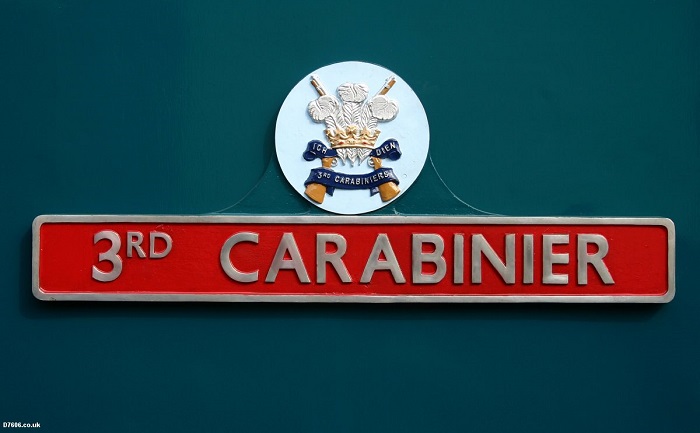
The sources of the 3rd Carabiniers reach back all the way to 1685 with the 4th Horse raised by the Earl of Plymouth (later 3rd Dragoon Guards) and the 9th Horse under Lord Lumley (6th Dragoon Guards). The latter were renamed the Kings Carabiniers in 1691 and were sent to Ireland.
In 1922 the 3rd & 6th Dragoon Guards combined, in 1928 they were renamed the 3rd Carabiniers (Prince of Wales Dragoon Guards).
During 1971 the 3rd Carabiniers were combined with the Royal Scots Greys to become the Royal Scots Dragoon Guards.
99 / 45135 was another long time LMR stalwart, spending nearly all its twenty six years at LMR depots. It was new to Derby in May 1961, not changing region until moved to Tinsley in November 1986. It had been named on New Year's Day 1966.
A general/refurbish was given at Derby Works during October 1981. A power unit defect caused the withdrawal of 45135 on March 9th 1987. After being stored for fifteen months 45135 was sold into preservation during August 1988.
![]()

In 1741 a regiment was raised up in the Nottingham area with initial service in Gibralter followed by movement to Nova Scotia, staying in Canada for the next twenty years. In 1745 the regiment was retitled the 45th Regiment of Foot, and after further service in Ireland & the American Colonies, the regiment returned home to become 'The Nottinghamshire Regiment'. Fifteen years in Martinique ended in 1802, suffering greater losses from yellow fever than from military action. It was on to Buenos Aires (1807), Rolica (1808) & Toulouse (1814).
The 1820s brought tours to Ceylon, India & Burma amongst others. South Africa was visited during the 1840s. In 1866 the regiment was granted the title 'Sherwood Forester'. This title was also confired upon the 95th Regiment of Foot, which had been created in 1823 and was also known as the Derbyshire Regiment. This had seen service in Malta, Ceylon and China before creating history at the Battle of Inkerman, in Crimea 1856, the regiment being the last to carry the Colours into any major battle. Casualties were high, less than one hundred survived. After Crimea it was off to Bombay for the Indian Mutiny and action at Awah, Kotah, Gwalior & Pouree, remaining in India until 1870.
In 1881 the 45th & 95th came together as the Sherwood Foresters, with more action in Egypt (1882), India and Tibet, followed by extensive service in the Boer War 1899 - 1902.
The Great War found the regiment with the BEF in France, with hard fighting at Aisne & Ennettiere. Others went to Gallipoli, only to return to France for the horrors of the Somme, Passchendaele & Ypres - in all 11,409 Foresters did not return. Inter-war service saw troops off to Egypt, Constantinople and India amongst other places.
World War Two took them with the BEF to France and others to a rough time in Norway. More went to Palestine & Egypt whilst those in Singapore were captured by the Japanese, some directed to work on the Burma - Siam Railway. Better fortunes were had at El Alamein, followed by landings in Italy at Salerno & Anzio, with hard fighting in the Cassino area. Greece was also visited. Casualties for the war were far less that The Great War, just over 1,500 killed and 4,500 hundred injured.
The post war era saw troops sent to Germany, Palestine, Malaysia (1958) and Cyprus (1963). During February 1970 the Sherwood Foresters amalgamated with the Worcester Regiment, to become the Worcester & Sherwood Foresters.
100 / 45060 was new to Derby during May 1961, being named later that year at Derby Station on September 23rd 1961, in the presence of 46112. 100 would always remain an LMR allocated locomotive. It was dual braked during 1975 and received its last major repair during January 1980. It had the rather melancholy task on July 23rd 1985 of towing eight withdrawn and heavily stripped Class 25's on their final journey from Derby to Swindon.
The end came for 45060 on December 8th 1985, withdrawn at Toton in full working order. After a year in storage it was sold for preservation during January 1987. It returned to its original split headcode look with the replacement of its nose ends by those taken from condemned 45053, the exchange being done at Toton during 1987.
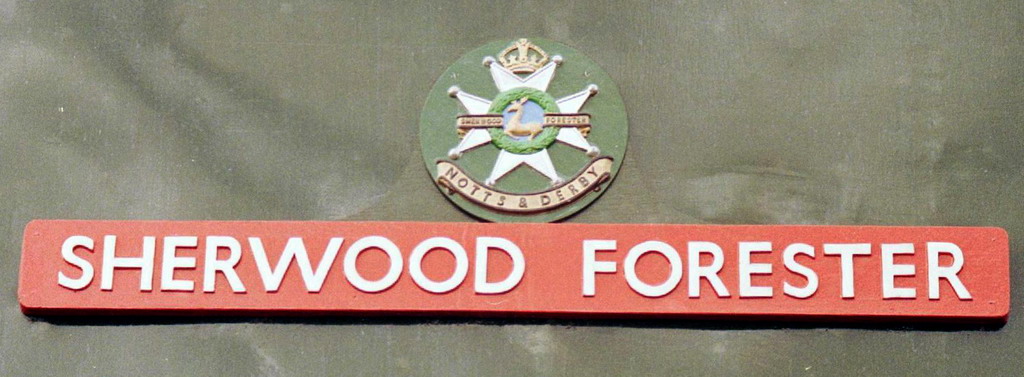
![]()
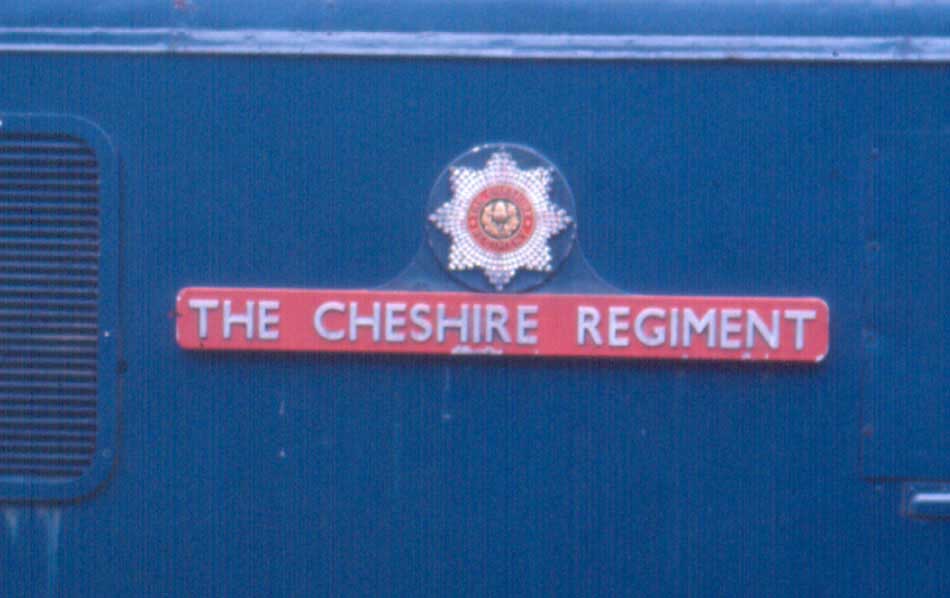
During 1689 regiments were raised to resist the actions of James 2nd, including men from the Wirral & Chester areas, under the leadership of Henry, Duke of Norfolk - initially known as the 22 Regiment of Foot, later becoming The Cheshire Regiment by 1782. Their first action was in Ireland, at Carrickfergus, Battle of The Boyne and Athlone in 1691.
It was then further afield to Jamaica for twelve years fighting the French and manning HM's ships. In 1726 a move was made to Minorca for a long twenty two years, then Canada in 1758 to Cape Breton Island to defeat the French. then came Martinique, the American Colonies (including Bunker Hill) & the West Indies. The 19th Century saw action in South Africa, India (Bhurtpore) & Mauritius. Further action in India occured at Meeanee, Hyderabad & Scinde. The century closed with action in the Boer War.
The Great War saw the regiment involved in every major action in France, also at Gallipoli, Sinai, Palestine & Mesopotamia, in total some 8,000 lives were given up in the conflicts. World War Two saw them in France with the BEF and the retreat to Dunkirk. Action followed in North Africa, Malta, Sicily, D-Day and crossing the Rhine. Post-war tours included Palestine, Egypt, Cyprus, Malaya, Singapore, Hong Kong, Belize and Bosnia.
137 / 45014 - numerically the last Class 45 in the original numbering scheme, it was not the last Class 45 built. 137 was new to Derby in December 1961, spending time on the LMR and at Leeds Holbeck, York & Tinsley before returning to Toton during January 1985.
It was named at Chester on June 12th 1966. Receiving a general repair at Derby Works in October 1980 it would remain in service until March 9th 1986 when it was involved in a collision at Chinley. Later moved to Manchester Ashton Road it was chopped into three pieces and removed by road to Vic Berry, Leicester for final disposal during September 1986.
![]()

The two components of this yeomanry developed along similar lines during their first hundred years. Both were formed to combat the possibilty of a French invasion, the Leicestershire Yeomanry in April 1794 and the Derbyshire Yeomanry six months later. Both fought their first major engagements in the Boer War 1899 - 1900.
During the Great War the two groups went their separate ways, the Leicestershire Yeomanry in most major battles in France, most importantly at Frezenburg. The Derbyshire Yeomanry were based in the Middle East, serving in Egypt, Macedonia, Strumma, Sulva, Scimitar Hill & Gallipoli.
World War Two found the Derbyshire Yeomanry still in the Middle East, highlights including at Tunis and El Alamein. The Leicestershire Yeomanry fought in North Africa, Italy & North West Europe.
The two Yeomanry were amalgamated in 1957 to become the Leicestershire & Derbyshire Yeomanry - they almost disappeared in 1968 but survived to become part of the Royal Anglian Regiment in 1977.
163 / 46026 was new to Derby in April 1962, being named shortly after delivery at Derby on April 14th. It would remain an LMR locomotive until May 1971 when it moved to Bristol Bath Road. 163 was renumbered to 46026 in February 1974. 46026's last repair was at Derby Works in August 1979. It remained on the WR until September 1980, having also been allocated to Cardiff Canton and Plymouth Laira, before being stored. After two months in store it was reallocated to Gateshead.
On St Patrick's Day 1984 46026 worked the last train to Consett, a railtour. Shortly afterwards on April 3rd it arrived Derby with traction motor problems, moving to Toton the next day. It was released from here on April 30th. 46026 was back at Gateshead May 4 - 11th for bogie attention returning by 15th with an auxiliary earth fault, released on 17th. Noted Crewe at the end of May, it suffered from flat batteries in June, being stopped at York on 7th and March on 23rd. On June 17 it worked the Class 46 Tribute tour out of Liverpool Street to SR destinations. July 7 - 12th stopped at Gateshead for cylinder head work. Held at York on 20th for brake work, then stopped at Penzance with low coolant. Returned to service on July 25th. Noted Exeter August 17th after main generator flashover, forwarded to Gateshead arriving 24th. Released by Gateshead on September 12th but battery problems continued until 18th. Returned to Gateshead on 23rd with power unit problems. Released October 12th, next noted at Bescot with camshaft problems on 23rd. Forwarded to Gateshead and released November 01. Whilst visiting the South West it encountered fuel problems on 6th, later failing at Severn Tunnel Junction with flat batteries on 9th. Moved to Gateshead and repaired. Its last duty was deputising for a failed Class 40 on the Grampian Highlander railtour, on the Derby - Newcastle leg on Saturday November 17. Condemnation came at Gateshead with main generator, traction motor and power earth faults. Noted Tyne Yard December 01 (?) with 46010/35/52 and moved as 19.15 to Doncaster on November 29 with 46035 as power. Broken up Doncaster Feb/March 1985
A replacement nameplate and crest were carried by 46026 for less that eighteen months was sold at auction for GBP11,400 in December 2003.
![]()
Page added July 14th 2005.
Last updated April 19th 2025.